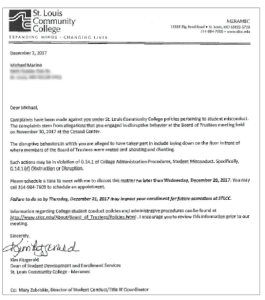Letters, meetings intended to ‘discourage political dissent’, says student Michael Marino
BY: MELISSA WILKINSON
Editor-in-Chief
 At least 10 Meramec students who participated in protests at the Nov. 30 Board of Trustees meeting were served with notices shortly after the incident. Delivered through both email and post, the notices requested a meeting with Kim Fitzgerald, Dean of Student Development and Enrollment Management.
At least 10 Meramec students who participated in protests at the Nov. 30 Board of Trustees meeting were served with notices shortly after the incident. Delivered through both email and post, the notices requested a meeting with Kim Fitzgerald, Dean of Student Development and Enrollment Management.
The protest began after the public speaking portion of the meeting, just before the board was to vote for the Reduction in Force (RIF), which would result in the laying-off of 58 STLCC faculty. Several students threw themselves onto the floor in front of the board table and continued to lay there chanting, “Justice for faculty.” Other students contributed to the chanting, and the protest went on for over an hour. The board ultimately did vote unanimously in favor of the RIF over the continued yells of students.
The notice, sent Dec. 7, cited the specific passage in STLCC’s code of conduct which was violated by the protesters and asked them to make an appointment to meet with Fitzgerald by Dec. 20. Included was a line warning students that, “Failure to do so may impact [their] enrollment for future semesters at STLCC.”
Michael Marino, one of the protesters, said the language in the letter was intentionally written to cause students to believe they could be expelled for their actions.
“It’s disappointing to see them using tactics of intimidation and fear to discourage political dissent,”
said Marino.
Fitzgerald, however, said the letters were not meant to be threatening and that disciplinary records do not travel with students, meaning they will not affect their ability to transfer to another school. According to Fitzgerald, the meetings were not intended to be a punishment for their actions.
“If you consider a conversation a punishment, that’s what it is,” said Fitzgerald. “We talked about responsibilities, accountability, consequences, thinking through their actions.”
According to Fitzgerald, the students in question violated STLCC’s Student Rights and Responsibilities policy, which forbids them from engaging in “obstruction or disruption of teaching, research, administration, disciplinary procedures, or other college-authorized activities.” Fitzgerald said her first priority in speaking with the students was to make sure that, in this “era of protest,” students understand that their actions have consequences and that they should think before acting in ways that might jeopardize their goals at STLCC.
“We like when students find their voice. That’s the conversation we have,” said Fitzgerald. “Where to use it and how to make it more effective. There are ways in which students can protest that can be considered non-disruptive.”
Mary Zabriskie, Director of Student Conduct and Title IX Coordinator, also attended the meetings alongside Fitzgerald. According to Marino, Zabriskie told the story of Phyllis Schlafly, a St. Louis native known for her extreme conservative activism. When Schlafly was given an honorary degree at Washington University, several faculty members turned their backs on the ceremony in silent protest, which Zabriskie said sent “a very powerful message.”
Marino described it as a lecture in “more effective civil disobedience.”
“I asked her ‘Did that work? Did they take away Phyllis Schlafly’s pretend degree?’ And no, she still has her pretend degree,” said Marino. “My question is if a pretend protest cannot get rid of a pretend degree, who are they to lecture me on civil disobedience?”
According to Marino, the protest at the Nov. 30 board meeting was a result of Chancellor Pittman dismissing previous attempts at negotiation by the Student Social Action Committee (SSAC), of which Marino is a member. Marino said it is a symptom of bigger problems within the administration.
“It wasn’t just that we want to fiddle with the budget. It’s that we have a fundamental and moral objection to [the administration’s] philosophy of running this college,” said Marino. “The administration wants to create an institution that helps students adapt to the system. We believe that an educational system should help enable people to adapt that system
to them.”
Marino first got involved in activism through protesting for adjunct rights, spending four days sleeping in a tent on campus in October. Marino said he intends to continue participating in SSAC activities throughout the rest of his time at STLCC.
Sean Thomas, however, decided to do the opposite. Thomas, who was also involved in the protests, ended his education at Meramec with only one class left to complete his associate’s degree.
“The chancellor said two of his biggest problems are graduation and retention rate. I’m not going to give him either,” said Thomas.
Thomas got involved with the SSAC after the October board meeting, during which Wildwood adjunct Steve Taylor was notoriously slammed to the ground by police whilst approaching the board. Thomas said his worst fear was not being able to speak out against the administration in the spring semester due to being “handcuffed” by his past record.
“To say that there was no disciplinary action taken is like saying this works the same way that a write-up at a job works. You know that we think you broke the policy and you will not be allowed to do it again. That is the administration letting us know that we’re going to give you this pass because you’re getting a lot of attention, but speak up again and there’s a chance that we will not let you attend school here,” said Thomas.
Thomas said the protesters expected immediate consequences at the board meeting once the protest began, but they were told neither to quiet down nor leave the room. According to Thomas, the Steve Taylor incident, which made national news, is why the meetings with Fitzgerald took place.
“I think that goes to show you that they understand that after tackling a professor, there’s no way you can be on video dragging students out of a meeting,” said Thomas. “So they decided to try to secretly punish us so that there would be no
public outcry.”
While Thomas said that the administration is in a worse place after sending the notices, Fitzgerald said she believes the college would be in a “much more vulnerable place” without having
addressed it.
“If we’re going to make an error I’d rather err on the side of conduct than overlooking it,” said Fitzgerald.
Fitzgerald, who has been at STLCC for 30 years, said her meetings with students are always enlightening.
“[STLCC] is where students come to make mistakes,” said Fitzgerald. “We’re taking every opportunity to help students learn.”
Students can access their rights through the Student Resources portal at stlcc.edu/student_resources.











